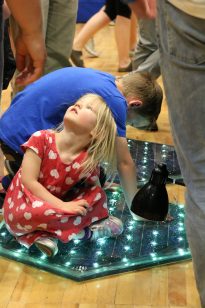Lights bedazzled the International Ballroom of the Bruce M. Pitman Center, as the best and brightest University of Idaho engineering students displayed their ideas for the future.
The annual Engineering Design EXPO gave UI engineers the chance to showcase a wide variety of projects, all with the goal of building a better world.
Bailey Poitra, a senior electrical engineering student, along with his team, worked with Solar Roadways in Sandpoint, Idaho, designing more effective solar panels to replace traditional asphalt roads.
Poitra said Solar Roadways tasked his team with forecasting how and when solar roads will become cost-efficient, as well as design a more practical heating element to melt snow and ice.

“The whole premise is basically to build a safer, more modular road that generates solar power,” Poitra said.
Poitra’s teammate, Silas Connolley, said the eventual benefits of solar roads will greatly outweigh the initial costs. Connolley said a single panel costs Solar Roadways $2,000 to build with their limited resources. However, he said the company believes the future is bright for this form of renewable energy.
“The future iterations will feature pressure sensitivity,” Connolley said. “If there’s a deer in front of you, the road would tell you to slow down.”

Leslie Kiebert | Argonaut
Children explore solar panels at the Engineering Expo Friday in the Pitman Center.
Connolley said other applications could include first responder use, as firefighters and police could warn traffic of the location of accidents and inform drivers of potential slowdowns in congested areas.
“In a 20-year period, it was actually cheaper to implement these solar roadway panels than it was it was to upkeep a parking lot that was made of asphalt,” Poitra said.
Meanwhile, Jacob Middleton and his team developed new ways for physical therapists to streamline the recovery process of stroke victims.
The project, which focuses on reduced mobility in the arm, featured multiple sensors attached to a patient’s shoulder and forearm. The sensors, Middleton said, would help doctors identify where patients were struggling and would assist patients in knowing which areas they needed to focus on.
“A lot of people are facing impairment of mobility in their arms,” Middleton said. “The idea here is a system of sensors will track the mobility of a patient’s arm and compare it to baseline for the physical therapist.”
He said many of the tools physical therapists use today are not as effective at recording data. The new digital design, which he and his team inherited from previous students, could fix this.
“Right now, physical therapists have an analog tool that measures the angle (of the arm),” Middleton said. “It would be better to have something digital that records a greater wealth of knowledge that they can work from and better understand how to improve their patient’s recovery process.”
Brandon Hill can be reached at [email protected] or on Twitter @brandonmtnhill
